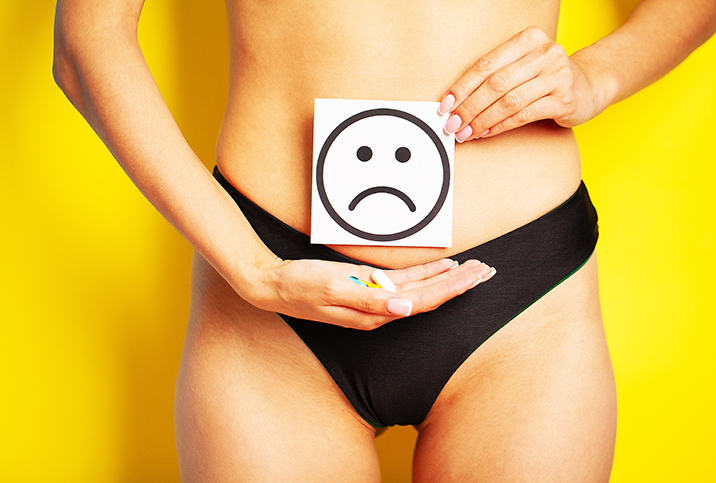How Long Do I Have to Wait for Sex After a Yeast Infection?

A yeast infection, while very common, comes with some uncomfortable symptoms that will likely keep you from wanting to have sex anytime soon.
Once you get your antibiotics, however, it's tempting to go straight to having sex again. But should you wait? How much time is needed before you can have sex after a yeast infection?
Also referred to as thrush, a yeast infection isn't considered a sexually transmitted infection (STI), therefore, there are no strict rules about when to start having sex once you're on the mend.
A yeast infection, more formally known as vulvovaginal candidiasis (VVC), is a fungal infection that causes discharge, irritation and itchiness of the vulva and the vagina. It's a common infection: 75 percent of women experience a yeast infection at least once in their lifetime, and many of them deal with it multiple times.
Symptoms and causes of yeast infection
"The labia and vagina are likely to be red and swollen. In severe cases, fissures—small cracks in the vaginal tissue—may develop. There is often a thick, white, cottage cheese-like discharge. Acute VVC can be extremely uncomfortable, with women saying their vagina is burning or feels on fire," said Deborah Lee, M.B.Ch.B., a sexual and reproductive health specialist at Dr. Fox, an online pharmacy headquartered in Bristol, England.
Our bodies are naturally colonized with Candida and other fungi, Lee explained, and we get symptoms when these fungi are actively growing and reproducing.
"The Candida filaments are called hyphae, and as these grow and branch out, they burrow under the superficial layers of the skin, which is thought to be what causes the itching," she said. "Men are colonized with Candida, too. But Candida is not passed partner to partner through sexual contact in the same way as chlamydia, for example."
While VVC is not an STI, there's an increased risk of getting it when a woman starts to have regular sexual activity for the first time. Sex can change the pH balance in the vagina, causing yeast to grow. Additionally, there is a potential link between mouth-to-genital contact and contracting a yeast infection.
Other factors that affect body chemistry and may cause yeast to overgrow include stress, pregnancy, weak immune system, health issues such as diabetes, the use of antibiotics, birth control pills or scented hygiene products, and wearing tight clothing.
Expert advice about sex after a yeast infection
Self-diagnosis is not a good idea if you're experiencing yeast infection symptoms for the first time. You should see a doctor if you're unsure of what you're dealing with, over-the-counter antifungal remedies haven't relieved your symptoms or you experience other symptoms as well.
There are no real rules about when you can have sex after treatment, according to Karen Morton, M.D., a consultant gynecologist and founder of Dr. Morton's, a medical helpline based in London.
"About a week should allow the inflammation to have settled so it's comfortable and won't reignite the problem," she said.
Lee also advised waiting seven days for the symptoms of an acute attack to settle before getting intimate.
"The local trauma to the vaginal tissues from sexual activity could disrupt the healing process and this could prolong the recovery period," she warned, adding that there's no need to see a doctor before recommencing sexual activity unless your symptoms haven't resolved.
Self-diagnosis is not a good idea if you're experiencing yeast infection symptoms for the first time.
Women with typical symptoms who have had VVC before are not always offered a swab test for Candida. If symptoms are persistent or recurrent, your VVC might be caused by less common Candida species, such as Candida glabrata, which requires a different antifungal treatment. Having a urine test for glucose could exclude a diabetes diagnosis.
Lee added that if a woman has VVC, her partner does not need to be tested or treated for Candida. However, men can get penile candidiasis, and if they develop symptoms, they should visit a doctor.
Furthermore, it's important to note that some STIs, such as chlamydia, gonorrhea and herpes, have similar symptoms to a yeast infection, and it's possible to have an STI on top of a yeast infection.
"Whenever women get any symptoms in the genital area, they almost always assume this is thrush," Lee advised. "It's not uncommon for a woman who assumed she had recurrent thrush to be suffering from recurrent attacks of herpes. Sometimes, vulval skin conditions such as lichen sclerosus or lichen planus can be found in women who thought they had recurrent thrush."
She added that it's time to book an STI screening to ensure no infections have been missed if you are 25 or younger, have had a new partner in the past three months or two or more partners in the past six months, or you have never been tested.
Preventing another yeast infection
Wearing underwear with a cotton crotch that isn't too tight-fitting can help reduce your risk of vaginal yeast infections. Other items and circumstances to avoid include:
- Hot tubs and very hot baths
- Staying in wet clothes, such as swimwear or gym gear, too long
- Unnecessary antibiotic use
- Scented products
- Douching, because it removes essential bacteria in the vagina that protect you from getting an infection
While precautionary methods such as these are important for maintaining a healthy vagina, don't feel bad if you get another yeast infection. Most women experience at least one—if not more—and it's easily treated. As the experts say, once those symptoms clear up and a week or so has gone by, you should be A-OK to restart your sex life.


















